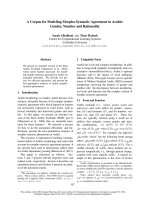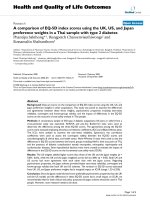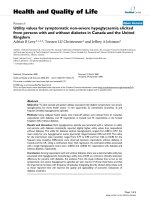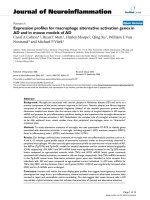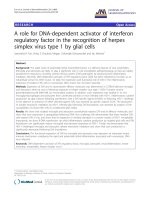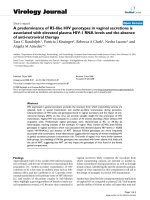Báo cáo hóa học: " A Technique for Dominant Path Delay Estimation in an OFDM System and Its Application to Frame " docx
Bạn đang xem bản rút gọn của tài liệu. Xem và tải ngay bản đầy đủ của tài liệu tại đây (1.12 MB, 8 trang )
Hindawi Publishing Corporation
EURASIP Journal on Wireless Communications and Networking
Volume 2006, Article ID 86147, Pages 1–8
DOI 10.1155/WCN/2006/86147
A Technique for Dominant Path Delay Estimation in an OFDM
System and Its Application to Frame Synchronization in OFDM
Mode of WMAN
Ch. Nanda Kishore and V. U. Reddy
Hellosoft India Pvt Ltd., 8-2-703, Road no. 12, Banjara Hills, Hyderabad 500 034, India
Received 15 February 2006; Revised 22 June 2006; Accepted 10 October 2006
Recommended for Publication by Sangarapillai Lambotharan
Orthogonal frequency division multiplexing (OFDM) is a parallel transmission scheme for transmitting data at very high rates
over time dispersive radio channels. In an OFDM system, frame synchronization and frequency offset estimation are extremely
important for maintaining orthogonality among the subcar riers. Recently, several techniques have been proposed for frame syn-
chronization in OFDM system. In multipath environment, the transmitted signal arrives at the receiver through direct and multiple
delayed paths. In some cases, it is possible that power of the signal arriving through delayed path may be larger than that of the
direct path (earliest path if there is no direct path). In those cases, estimate of the frame boundary may be shifted by a quantity
equal to the delay of the dominant path. In such cases, there will be intersymbol interference (ISI) in the demodulated symbols
unless the frame boundary estimate is preadvanced such that it dwells in the ISI-free portion of cyclic prefix or at the symbol
boundary. In this paper, we propose a method for estimating the shift in the frame boundary estimate using a preamble having
two identical halves. We assume that frame boundary and frequency offset estimation have been performed prior to the estimation
of the shift. We also examine the quality of the frequency offset estimate when the frame boundar y estimate is shifted from the
desired value. The proposed method is applied to downlink synchronization in OFDM mode of WMAN (IEEE 802.16-2004). We
use simulations to illustrate the usefulness of the method and also to support our assertions.
Copyright © 2006 Ch. N. Kishore and V. U. Reddy. This is an open access article distributed under the Creative Commons
Attribution License, which permits unrestricted use, distribution, and reproduction in any medium, provided the original work is
properly cited.
1. INTRODUCTION
Orthogonal frequency division multiplexing (OFDM) is a
multicarrier modulation scheme for transmitting data at very
high rates over multipath radio channels. Recently, OFDM
has been adopted as a modulation technique in wireless
metropolitan area network (WMAN) standard [1]. In OFDM
system, timing and frequency synchronization are crucial for
the retrieval of information (see [2]). Several techniques have
been recently proposed for OFDM frame and frequency syn-
chronization.
In multipath environment, the transmitted signal arrives
at the receiver through multiple paths and the correspond-
ing signals are delayed with respect to direct path or earliest
path if there is no direct path. In some cases, power of the
signal arriving through a delayed path is larger than that of
the signal from the earliest path (we refer to the correspond-
ing delayed path as the dominant path). In those cases, es-
timate of the frame boundary may be shifted by a quantity
equal to the delay of the dominant path (the delay is mea-
sured with respect to the arrival time of the earliest path). In
[3], Yang et al. proposed a method that uses pilot subcarriers
throughout the frame for estimating the shift in the frame
boundary. However, their approach requires huge memory
to store around 10 estimates of channel impulse responses
and also the received samples corresponding to 10 OFDM
symbols, thereby introducing a delay of 10 OFDM symbols in
the demodulation process. To correct the error in the bound-
ary estimate due to channel dispersion, the authors in [4]
suggest a method which is computationally expensive due to
matrix operations involved. For finding the channel impulse
response, their method takes around LM complex multipli-
cations and additions where M is the length of the repeated
training symbol segment and L is the length of the cyclic pre-
fix (CP). Moreover, both methods [3, 4] find the channel im-
pulse response using the received OFDM symbols starting
2 EURASIP Journal on Wireless Communications and Networking
from the preadvanced boundary, where preadvancement is
chosen by an arbitrary amount, and find the first significant
channel tap by testing the tap power in a window of L
using
a threshold. T his preadvancement may degrade the estima-
tion performance in the cases where the preadvanced frame
boundary falls in the interference portion of CP.
In this paper, we propose a method for estimating the
shift in the fr ame boundary using a preamble having two
identical halves. This is the same as the first symbol of the
preamble considered in [5] and the second symbol of the
preamble specified for downlink mode of WMAN-OFDM.
Our method requires 2M complex multiplications for find-
ing the channel impulse response and a memory to store
samples of two received OFDM symbols. We assume that
frame boundary and frequency offset estimation have been
performed prior to the shift estimation. We examine the
quality of the frequency estimate when the frame bound-
ary estimate is shifted from the desired value. Though the
method is based on the preamble cited above, it is not re-
stricted to the way the frame boundary and frequency off-
set are estimated. The proposed method integrates very well
with our synchronization technique [6], and for this reason,
we g ive the steps of the algorithm of [6] for the sake of conti-
nuity. The method is applied to downlink synchronization in
OFDM mode of WMAN (IEEE 802.16-2004). We use simu-
lations to illustrate the usefulness of the method and also to
support our assertions.
The rest of the paper is organized as follows. Section 2
gives briefly the background of the frame synchronization
technique [6]. Quality of frequency offset estimate as given
by the algorithm of [6], when the frame boundary estimate
is shifted from the desired symbol boundary, is examined in
Section 3 and simulation results to support our assertions
in this regard are also given in this section. T he proposed
method of estimating the shift in the frame boundary and
simulation results to illustrate its effectiveness in the frame
synchronization are presented in Section 4.Performanceof
the method when applied to downlink synchronization in
WMAN-OFDM mode is demonstrated through simulations
in Section 5. Finally, Section 6 concludes the paper.
2. BACKGROUND
The samples of the base-band equivalent OFDM signal are
given by
x( n)
=
1
N
N 1
k=0
X(k)e
j2πk(n L)/N
,(1)
where 0
n N + L 1, N is the total number of carriers,
X(k) is the kth subsymbol, j
= 1, and L is the length
of cyclic prefix (CP), which is assumed to be longer than
the length of channel impulse response. The signal is trans-
mitted through a frequency selective multipath channel. Let
h(n) denote the base-band equivalent discrete-time channel
impulse response of length υ. A carrier frequency offset of
(normalized with subcarrier spacing) causes a phase rotation
of 2π
n/N. Assuming a perfect sampling clock, the received
CP MM
Figure 1: Preamble, preceded by CP, considered for the proposed
method.
samples of the OFDM symbol are given by
r(n)
= e
j[(2πn/N)+θ
0
]
υ
1
l=0
h(l)x(n l)+η(n), (2)
where θ
0
is an initial arbitrary carrier phase and η(n)isazero
mean circularly symmetric complex white Gaussian noise
with variance σ
2
η
. In this paper, we consider packet-based
OFDM communication system, where a preamble is placed
at the beginning of the packet. We consider an OFDM sym-
bol with two identical halves, as shown in Figure 1, as the
preamble. The two halves of this symbol are made identical
(in time domain) by loading even carriers with a pseudonoise
(PN) sequence. This is the same as the second symbol of the
preamble specified in [1] and also the first symbol of the
preamble considered in [5].
The samples of the transmitted preamble (excluding CP)
are given by
a(n)
=
1
N
M 1
k=0
A(2k)e
j(2π/M)kn
,0n N 1, (3)
where M
= N/2withN denoting the sy mbol length, A(2k),
for 0 <k
M 1, is the PN sequence that is loaded on
even subcarriers, and A(2k +1)
= 0for0 k M 1[1].
The samples a(n), for n
= 0, 1, , M 1, are assumed to be
known to the receiver. We now introduce briefly the frame
boundary and frequency estimation technique of [6].
The timing metric, as given in [6], is given by
M(d)
=
P(d)
2
R
2
(d)
,(4)
where P(d)andR(d)are
P(d)
=
M 1
i=0
r(d + i)a(i)
r(d + i + M)a(i)
,
R(d)
=
M 1
i=0
r(d + i + M)
2
.
(5)
The superscript “
” denotes complex conjugation, r(n)are
the samples of the base-band equivalent received signal, and
d is a sample index corresponding to the left edge of a win-
dow of 2M samples. R(d) gives an estimate of the energy in
M samples of the received signal. For a specified SNR, mean
and variance of M(d) are analytically evaluated for AWGN
channel, and a threshold is selected based on them. We then
estimate the symbol boundary as follows.
(i) Compute the timing metric M(d)fromablockofN
received samples, shifting the block by one sample index each
Ch.N.KishoreandV.U.Reddy 3
time, and find the sample index d
th
where M(d) crosses the
threshold.
(ii) Evaluate M(d) in the interval d
th
<d (d
th
+ L 1).
(iii) Find the sample index where M(d) is largest in the
interval d
th
d (d
th
+ L 1). This sample index is taken as
the estimate of the preamble boundary.
(iv) If the metric M(d) does not cross the threshold at all,
declare the detection as a miss detection.
After the symbol boundary estimate is found, we perform
frequency offset estimation. Let the ac tual frequency offset be
= m + δ with m Z and δ < 1. Then, the estimate of
= (m + δ m) = m (6)
is given by
=
φ
π
,(7)
where
φ = angle
P
d
opt
(8)
with d
opt
denoting the sample index corresponding to the es-
timate of the preamble boundary. Here,
is the fractional
part and
m is the integer part such that their sum is the ac-
tual offset m + δ.
m is an even integer closest to since the
repeated halves of the preamble are the result of loading the
even subcarriers with nonzero value and the odd subcarriers
with zero value. The estimate of
m is obtained from the bin
shift as outlined below.
Let r(d
opt
+n), n = 0, 1, , N 1, be the received pream-
ble symbol. This sequence is first compensated with the frac-
tional offset estimate
giving
c(n)
= e
j2π
n/N
r
d
opt
+ n
, n = 0,1, , N 1. (9)
The bin shift estimation is then perfor m ed as follows.
(i) Obtain the product sequence c(n)a
(n)forn = 0,
1, , M
1.
(ii) Evaluate the M-point DFT of the product sequence
obtained in step ( i).
(iii) Find the bin l
1
corresponding to the largest magni-
tude DFT coefficient. Then, 2l
1
is the estimate of m.
3. QUALITY OF FREQUENCY OFFSET ESTIMATE
WHEN THE FRAME BOUNDARY ESTIMATE
SHIFTS DUE TO DOMINANT PATH
Since we carry out estimation of the shift in the frame bound-
ary estimate after compensating the received preamble with
the frequency offset estimate, consisting of both fractional
and integer parts, one needs to know if the quality of this
estimate, as given by the algorithm of [6], is affected when
the frame boundary estimate shifts due to dominant path.
Let τ be the difference between the estimate of the pream-
ble boundary and the actual value which we denote by d
s
,
that is, d
opt
= d
s
+ τ. Then, samples of the received signal
starting from d
opt
are given by
r
d
opt
+ n
=
e
jθ(n)
s(n + τ)+η
d
opt
+ n
,0n N τ 1,
(10)
where s(n)
=
υ 1
p
=0
h(p)a((n p)modM)andθ(n) =
2π(n + τ)/N + θ
0
for 0 n N τ 1.
Recall that the fractional frequency offset is estimated
from the angle of P(d
opt
), which is given by
P
d
opt
=
M 1
i=0
r
d
opt
+ i
r
d
opt
+ i + M
a(i)
2
. (11)
Substituting (10)in(11) and using the relation (6), we get
P
d
opt
=
e
jπ
M τ 1
i=0
s(τ + i)
2
a(i)
2
+
M τ 1
i=0
e
jθ(i)
s (τ + i) η
d
opt
+ M + i
a(i)
2
+
M τ 1
i=0
e
j[θ(i)+π]
s(τ + i)η
d
opt
+ i
a(i)
2
+
M τ 1
i=0
η
d
opt
+ i
η
d
opt
+ M + i
a(i)
2
+
M 1
i=M τ
r
d
opt
+ i
r
d
opt
+ M + i
a(i)
2
.
(12)
Note that the first four terms will be present even when τ
=0.
For τ
= 0, the magnitude of the last term is very small com-
pared to that of the first since r(d
opt
+ n)andr(d
opt
+ M + n)
for n
M τ correspond to short segments of the received
preamble and data symbols, respectively, which are uncorre-
lated. Thoug h the upper limit in the sum for the first four
terms differs from M
1, its effect on the estimate of frac-
tional part
is negligible because of the following.
(i) In practice, τ is very small compared to M.
(ii) The magnitudes of the second, third, and fourth
terms are very small compared to that of the first because
signal and noise are assumed to be uncorrelated and noise is
assumed to be white.
We, therefore, conclude that the quality of the estimate of
fractional part
will be nearly the same as that when there is
no shift in the frame boundary estimate. Simulation results
given below support this statement.
The integer part is estimated in [6] by finding the M-
point DFT of the sequence c(n)a
(n)(see(9)forc(n))
R
AC
(2l) =
M 1
i=0
c(i)a (i)e
j2πli/M
(13)
and the index (2l
1
), where l
1
corresponds to the DFT coef-
ficient with largest magnitude, gives the estimate of integer
part
m.From(9)and(10), and assuming that variance of the
4 EURASIP Journal on Wireless Communications and Networking
error (
)isverysmall,(13) can be expressed as
R
AC
(2l)
M 1
i=0
e
j[(2π/N)mi+θ
1
]
υ 1
p=0
h(p)a
(i + τ p)modM
a (i)e
j2πli/M
+
M 1
i=0
η
d
opt
+ i
a (i)e
j(2π/N)li
,
(14)
where θ
1
= (2π/N)τ +θ
0
and η (d
opt
+i) = e
j2π
η(d
opt
+i).
Interchanging the summations, (14)canberewrittenas
R
AC
(2l) e
jθ
1
h(τ)
M 1
i=0
a(i)
2
e
j(2π/M)(m/2 l)i
+ e
jθ
1
υ 1
p=0, p=τ
h(p)
M 1
i=0
a
(i + τ p)modM
a (i)e
j(2π/M)(m/2 l)i
+
M 1
i=0
η
d
opt
+ i
a (i)e
j2π/Nli
.
(15)
We note, once again, that the three terms will be present even
when τ
=0, and the last term is independent of τ.For2l = m,
the magnitude of the first term is much larger than that of
the second for the following reasons.
(i) The magnitude of the coefficient h(τ), corresponding
to the dominant path, is assumed to be significantly larger
than the magnitudes of other coefficients.
(ii) The quantities corresponding to the sum in the first
term and the inner sum in the second term represent cyclic
autocorrelation of the sequence a(i)forzeroand(τ
p)lags,
respectively, for 2l
= m. Since a(i), 0 i M 1, is the
time domain sequence obtained from a frequency domain
loading by a PN sequence (see (3)), its zero-lag autocorre-
lation magnitude is much larger than that of a nonzero lag.
The mag nitude of lag-one autocorrelation, which is the next
largest value, is found to be 12 dB lower.
In view of the above, the estimate of integer part,
m,will
be nearly the same as the value we get when there is no shift
in the frame boundary. Simulations given below support this
assertion.
Simulations
To examine the quality of frequency offset estimate in the
presence of a shift in the frame boundary estimate in fre-
quency selective channels, we have performed simulations.
The preamble is generated with 200 used carriers, 56 null
carriers—28 on the left and 27 on the right, and a dc car-
rier. The even (used) carriers are loaded with a PN sequence
given in [1]forOFDMmode.Afrequencyoffset of 10.5
times the subcarrier spacing and a cyclic prefix of length 32
Table 1: Integer frequency offset estimate
m, mean and standard
deviations of fractional frequency offset estimate
(actual fre-
quency offset
= 10.5 and SNR = 9.4dB).
Channel
type
Mean
Standard
deviation
Integer frequency offset
estimate
SUI-1 0.5007 0.0104 10 in 243 realizations
SUI-2 0.5009 0.0107 10 in 243 realizations
SUI-3 0.5007 0.0103 10 in 243 realizations
samples are assumed in the simulations. Stanford University
Interim (SUI) channel modeling [7]isusedtosimulateafre-
quency selective channel. The impulse response of the chan-
nel is normalized to unit norm. Variance of a zero mean com-
plex white Gaussian noise that is added to the signal compo-
nent, which is the transmitted preamble in AWGN case and
is the convolution of transmitted preamble and channel im-
pulse response in the case of SUI channels, is adjusted ac-
cording to the required SNR. A SNR of 9.4 dB is assumed in
the simulations as it is the recommended SNR for the pream-
ble [1]. The received signal generated as above is preceded
by noise and followed by data symbols. We considered 250
different realizations of SUI channels where the second tap
of the channel impulse response, corresponding to τ
= 5,
is largest in amplitude. The fractional and integer frequency
offsets are estimated using the algorithm of [6] for all these
realizations. From the 250 results, the mean and standard de-
viations of the fractional frequency offset estimate, and the
number of times the integer frequency offset estimate is equal
to the true value, are found (see Table 1). We note from the
results that the mean of the fractional frequency offset esti-
mate is very close to the tr ue value and the standard devia-
tion is very small. The integer frequency offset estimate is 10
in 97% of the realizations.
4. ESTIMATION OF THE SHIFT IN THE
FRAME BOUNDARY
After estimating the integer frequency offset, the same M
samples c(n)(see(9)) are further compensated with this es-
timate as given below
b(n)
= e
j2π(
m)n/N
c(n), n = 0, 1, , M 1. (16)
From (9)and(10), and assuming that
m = m and variance
of error (
)isverysmall,(16) can be expressed as
b(n)
e
jθ
1
υ 1
l=0
h(l)a
(n + τ l)modM
+ η
d
opt
+ n
,
(17)
Ch.N.KishoreandV.U.Reddy 5
where η (d
opt
+ n) = e
j(2π/N)(
m+
)n
η(d
opt
+ n)andθ
1
=
(2π/N)τ + θ
0
. Taking M-point DFT of b(n), we have
B(k)
=
1
M
M 1
n=0
b(n)e
j(2π/M)kn
(18)
which, in view of (17), can be written as
B(k)
=
e
jθ
1
M
M 1
n=0
υ
1
l=0
h(l)a
(n + τ l)modM
e
j(2π/M)kn
+
1
M
M 1
n=0
η
d
opt
+ n
e
j(2π/M)kn
.
(19)
Note here that the spacing of DFT bins B(k) is twice that of
A(k).
Substituting (3) into (19) and simplifying, we get
B(k)
=
M
2
e
jθ
1
A(2k)H(k)e
j(2π/M)kτ
+ W(k), (20)
where H(k)
= (1/
M)
υ 1
l
=0
h(l)e
j(2π/M)lk
and W(k) =
(1/ M)
M 1
n=0
η (d
opt
+ n)e
j(2π/M)nk
.TheestimateofH(k)
is then given by
H(k) =
B(k)
A(2k)
=
M
2
e
jθ
1
H(k)e
j(2π/M)kτ
+
W(k)
A(2k)
.
(21)
Taking M-point IDFT of (21)gives
h(n) =
M
2
e
jθ
1
h(n + τ)+w(n), (22)
where
w(n)
=
1
M
M 1
k=0
W(k)
A(2k)
e
j(2π/M)kn
(23)
is a zero mean complex Gaussian noise with variance
(σ
2
η
/M)
M 1
k
=0
(1/
A(2k)
2
), and
h(n) =
1
M
M 1
k=0
H(k)e
j(2π/M)kn
. (24)
We make use of the FFT block available at the receiver
twice, once for computing B(k) and next for computing
h(n).
The method requires 2M complex multiplications for the es-
timation of channel impulse response. The use of the FFT
block twice introduces delay of approximately two OFDM
symbols. Consequently, the method requires a memory to
store received samples corresponding to two OFDM symbols
before the demodulation of the received OFDM data sym-
bols.
Using the estimated channel impulse response, we test
the tap power in a window of L
to find the shift in the esti-
mate of the impulse response h(n), corresponding to the shift
in the frame boundary estimate τ. Since the preamble we use
has two identical halves, picking up M samples from the es-
timated boundary will not fall in the interference portion of
CP. As τ
L, τ is estimated as
τ = M arg max
d
E
h
(d):M L d M 1
, (25)
where E
h
(d) is the energy in the estimated channel impulse
response in a window of length L
,givenby
E
h
(d) =
L 1
l=0
h
(d + l)modM
2
. (26)
An appropriate value for L
is the channel delay spread υ
since the dominant path corresponds at most to the last coef-
ficient of the channel response. Since we do not have a priori
knowledge of the channel length, one can choose L
= L.If
L
>υ, E
h
(d) will have a plateau of length L υ.Ifwepread-
vance the frame boundary estimate with
τ obtained from
(25), it falls in the interval covering ISI-free portion of CP or
at the preamble boundary. With the corrected frame bound-
ary estimate, there will be no ISI in the demodulated OFDM
symbols at the output of FFT.
Simulations
To illustrate the usefulness of the proposed dominant path
delay estimation, we conducted the following simulations.
We generated the preamble and noise as described in Section
3. We estimated the frame boundary, d
opt
, and frequency off-
set from the signal modeled as in (2) following the technique
of [6], and then estimated the dominant path delay τ as de-
scribed above. We then preadvanced d
opt
by τ. Starting from
the corrected boundary estimate, we selected N samples from
the noise-free and f requency offset-free signal modeled as
r(n)
=
υ 1
l=0
h(l)x(n l) (27)
and computed its DFT. If the DFT coefficients R(k)arezero
for odd values of k, we declare the detection of the frame
boundary as correct. Otherwise, we declare it as a false de-
tection. We repeated this step for the uncorrected boundary
estimate case too. This measure is equivalent to checking if
the frame boundary estimate, after correction by
τ,fallsin
the interval covering ISI-free portion of CP or at the frame
boundary.
We considered 1000 realizations of AWGN, SUI-1, SUI-2,
and SUI-3 channels, choosing a di fferent realization of noise
and channel in each case. The results are shown in Ta ble 2.
We note from the results that preadvancement of the pream-
ble boundary estimate by
τ enhances the detection perfor-
mance, in particular for SUI-2 and SUI-3 channels.
To further demonstrate the practical utility of the domi-
nant path delay estimation method described here, we per-
formed simulations to find bit error rate (BER) with and
without dominant path delay estimate compensation. The
6 EURASIP Journal on Wireless Communications and Networking
Table 2: Detection performance with and without preadvancement of the frame boundary estimate (number of realizations = 1000, SNR =
9.4dB).
Channel
without preadvancement with preadvancement
False detections Correct detections False detections Correct detections
AWGN 0 1000 0 1000
SUI-1
3 996 0 999
SUI-2
40 952 6 986
SUI-3
198 752 6 948
simulation setup is the same as the one described in Section 3
except that we considered 1000 realizations of SUI-1, SUI-2,
and SUI-3 channels whose second tap has the largest mag-
nitude among all the three taps. We appended OFDM data
symbols to the preamble, where these symbols are generated
by loading data subcarriers with BPSK or QPSK subsymbols
as in [1], to form an OFDM packet. We did not use any for-
ward error correction (FEC) technique in the simulations.
For each realization of the channel, the generated OFDM
packet is convolved with channel impulse response and noise
is added to the convolved output to give the received packet.
We performed the frame and frequency synchronization
on each received packet as described in Section 2.Weob-
tained the estimate of the channel frequency response at
the even carriers from (21) and estimated the frequency re-
sponse at the odd carriers by linear interpolation. We then
performed frequency domain equalization of the received
data symbols. After demapping the equalized subsymbols, we
computed BER. We repeated this with dominant path delay
estimate compensation. The average BER computed from the
results of 1000 realizations is shown in Figures 2 and 3.
From Figures 2 and 3, we observe that without pread-
vancement of the preamble boundary estimate by the dom-
inant path delay estimate the BER remains almost constant
beyond 20 dB SNR, while with preadvancement it falls with
SNR. These results clearly bring out that preadvancement of
the preamble boundary estimate with the dominant path de-
lay estimate is necessary.
5. APPLICATION TO DOWNLINK SYNCHRONIZATION
IN WMAN-OFDM
The WMAN-OFDM physical layer is based on the OFDM
modulation with 256 subcarriers. For this mode, the pream-
ble consists of two OFDM symbols. Each of these symbols is
preceded by a cyclic prefix (CP), whose length is the same
as that for data symbols. In the first OFDM symbol, only
the subcarriers whose indices are multiple of 4 are loaded.
As a result, the time domain waveform (IFFT output) of the
first symbol consists of 4 repetitions of 64-sample fragment.
In the second OFDM symbol, only the even subcarriers are
loaded which results in a time domain waveform consisting
of 2 repetitions of 128-sample fragment. The corresponding
preamble structure is shown in Figure 4. In the downlink
synchronization, we have to estimate the symbol boundary,
frequency offset, and the CP value u sing the preamble given
5 1015202530354045
10
4
10
3
10
2
10
1
10
0
SNR (dB)
BER
SUI 1, without compensation
SUI
1, with compensation
SUI
2, without compensation
SUI
2, with compensation
SUI
3, without compensation
SUI
3, with compensation
Figure 2: BER versus received SNR, with and without dominant
path delay estimate compensation, in SUI channels with BPSK map-
ping.
in Figure 4. To evaluate the CP value, we estimate the left
edge of one of the 64-sample segments and the left edge of
the second symbol following the approach given in [6], and
evaluate the CP from
L = Q
d
2
d
1
1
mod 64
, (28)
where d
1
and d
2
are sample indices corresponding to the es-
timates of the left edges of one of the first three segments
of the first symbol and the second symbol, respectively. d
1
and d
2
are obtained using the practical detection strategy de-
scribed in [6]. The function Q(x) denotes quantization of x
to a value nearest to 8, 16, 32, and 64 (or 0), corresponding
to CP lengths of 8, 16, 32, and 64, respectively. Then, we pro-
ceed with the estimation of shift in the left edge of the second
symbol and preadvance it by the estimate
τ.
We conducted the simulations using the preamble shown
in Figure 4 and the same simulation setup as in the previous
section. The results are given in Table 3.Wenotefromthere-
sults that preadvancement enhances the correct detection of
the frame boundary, particularly in SUI-2 and SUI-3 chan-
nels. The results show that the CP estimate is correct even in
Ch.N.KishoreandV.U.Reddy 7
Table 3: Detection of the frame boundary with and without preadvancement by τ, and the number of times the CP is estimated correctly
(number of trials
= 1000, SNR = 9.4dB).
Channel
Before preadvancement After preadvancement
False Correct CP False Correct
AWGN 0 1000 1000 0 1000
SUI-1
3 997 1000 0 1000
SUI-2
32 961 987 2 991
SUI-3
174 791 937 5 960
5 1015202530354045
10
4
10
3
10
2
10
1
10
0
SNR (dB)
BER
SUI 1, without compensation
SUI
1, with compensation
SUI
2, without compensation
SUI
2, with compensation
SUI
3, without compensation
SUI
3, with compensation
Figure 3: BER versus received SNR, with and without dominant
path delay estimate compensation, in SUI channels with QPSK
mapping.
CP 64 64 64 64 CP 128 128
Figure 4: Downlink preamble structure in WMAN-OFDM mode.
those cases where the left edge of the second symbol is not de-
tected correctly. This is because shifts in the left edges of the
detected segment and the second symbol do not affect the
CP estimate if the difference between the shifts is less than 4
samples. We have found that estimating the shifts and cor-
recting the edge estimates prior to evaluating the CP did not
make any difference in the CP estimates.
The small difference in the number of correct detections
between Tab le 2 and Table 3 may be because (i) noise realiza-
tions in the two cases are different and (ii) search intervals
over which we find the maximum value of the metric are dif-
ferent (the interval is 32 for the results of Table 2 while it is
64 for those of Ta ble 3). The number of misdetections in the
case of SUI-3 channel is fewer in WMAN-OFDM case be-
cause computation of the timing metric for the detection of
the symbol boundary starts earlier in this case.
6. CONCLUSIONS
In a multipath radio environment, the transmitted signal ar-
rives at the receiver through multiple delayed paths. In some
cases, the power of the signal arriving through a delayed path
may be larger than that of the earliest path. In those cases, the
estimate of the frame boundary may be shifted by a quan-
tity equal to the delay of the dominant path. We presented a
method to estimate the shift in the frame boundary caused by
the dominant path. We also examined the quality of the fre-
quency offset estimate, given by [6], in the presence of a shift
in the frame boundary. We illustrated the usefulness of the
correction of the frame boundary estimate through simula-
tions. The simulation results show that without preadvance-
ment of the frame boundary estimate by the dominant path
delay estimate, the BER saturates beyond 20 dB SNR of the
received signal with BPSK/QPSK mapping while w ith pread-
vancement it falls with SNR. We have also discussed the ap-
plication of the proposed method to downlink synchroniza-
tion in WMAN-OFDM a nd presented some simulation re-
sults to demonstrate its utility.
ACKNOWLEDGMENTS
Ch. Nanda Kishore would like to thank S. Rama Rao, Vice
President and General Manager of Hellosoft India Pvt. Ltd.
and Dr. Y. Yoganandam, Senior Technical Director of Hel-
losoft India Pvt. Ltd. for their constant encouragement and
support. The authors would also like to acknowledge the use-
ful discussions they had with their colleague K. Kalyan dur-
ing the course of this work.
REFERENCES
[1] Part 16: Air Interface for Fixed Broadband Wireless Access Sys-
tems, IEEE Std. 802.16, 2004.
[2] M.Speth,S.A.Fechtel,G.Fock,andH.Meyr,“Optimumre-
ceiver design for wireless broad-band systems using OFDM-
part I,” IEEE Transactions on Communications, vol. 47, no. 11,
pp. 1668–1677, 1999.
[3] B. Yang, K. B. Letaief, R. S. Cheng, and Z. Cao, “Timing recov-
ery for OFDM transmission,” IEEE Journal on Selected Areas in
Communications, vol. 18, no. 11, pp. 2278–2291, 2000.
[4] H. Minn, V. K. Bhargava, and K. B. Letaief, “A robust timing and
frequency synchronization for OFDM systems,” IEEE Transac-
tions on Wireless Communications, vol. 2, no. 4, pp. 822–839,
2003.
8 EURASIP Journal on Wireless Communications and Networking
[5] T. M. Schmidl and D. C. Cox, “Robust frequency and timing
synchronization for OFDM,” IEEE Transactions on Communi-
cations, vol. 45, no. 12, pp. 1613–1621, 1997.
[6] Ch. N. Kishore and V. U. Reddy, “A fr ame synchronization and
frequency offset estimation algorithm for OFDM system and
its analysis,” EURASIP Journal on Wireless Communications and
Networking, vol. 2006, Article ID 57018, 16 pages, 2006.
[7] V. Erceg, K. V. S. Hari, M. S. Smith, et al., “Channel models
for fixed wireless applications,” Tech. Rep. IEEE 802.16a-03/01,
2003.
Ch. Nanda Kishore received the B.Tech. de-
gree in electronics and communication en-
gineering from Jawaharlal Nehru Techno-
logical University, Hyderabad, India, in June
2000. He joined Hellosoft India Pvt Ltd.,
Hyderabad, India, in July 2000. At Hel-
losoft, he worked in various projects includ-
ing digital line echo canceler (LEC), chan-
nel coding for GSM/GPRS, PBCC mode of
WLAN, and physical layer design for wire-
less met ropolitan area network. He received his M.S. degree in
communication s ystems and signal processing from International
Institute of Information Technology, Hyderabad, India, in June
2005. Presently he is working in very high bit rate digital subscriber
line (VDSL) project. He has been awarded a US patent recently
for his work on cyclic FIRE decoder for GSM/GPRS system. His
research interests include wireless communications, digital signal
processing, and error-control coding.
V. U. Reddy was on the Faculty of IIT,
Madras, IIT, Kharagpur, Osmania Univer-
sity and Indian Institute of Science (IISc),
Bangalore. At Osmania University, he estab-
lished the Research and Training Unit for
Navigational Electronics (he was its Found-
ing Director). At IISc, he was the Chair of
Electrical Communication Engineering De-
partment during 1992–1995. After retiring
from IISc in 2001, he joined the Hellosoft
India Pvt. Ltd., as CTO. In June 2003, he moved to International
Institute of Information Technology, Hyderabad, as the Microsoft
Chair Professor, and returned to Hellosoft as the Chief Scientist in
December 2005. He held several visiting appointments with the
Stanford University and the University of Iowa. His areas of re-
search have been adaptive and sensor array signal processing, and
during the last 10 years he has been focusing on the design of
OFDM-based physical layer with applications to DSL, WLAN, and
WiMax modems. He was on the editorial boards of the Indian Jour-
nal of Engineering and Materials Sciences, and Proceedings of the
IEEE. He was the Chairman of the Indian National Committee
for International Union of Radio Science during 1997–2000. He is
a Fellow of the Indian Academy of Sciences, the Indian National
Academy of Engineering, the Indian National Science Academy,
and the IEEE.

